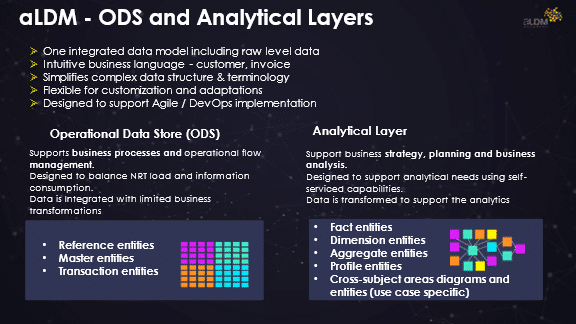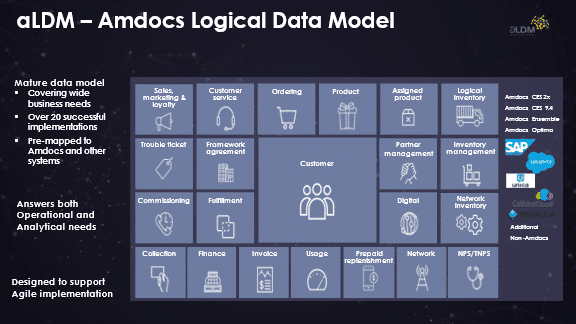 Company: Amdocs
Company: Amdocs
Product Title: Amdocs Logical Data Model (aLDM)
Product Version: 10.1
Information Framework version: Version 16.0
Assessment Completion Date: February 2017
Detailed Certification Report: Amdocs Logical Data Model (aLDM) Conformance Certification Report v1.0
Amdocs Logical Data Model (aLDM)
Amdocs Logical Data Model (aLDM) addresses communication & media service providers’ data management challenges, empowering them as they transform into data-centric organizations. It delivers value by capturing and modeling data in a format and structure that supports reporting and ETL loads.
Key benefits:
- Simplifies complex data structure and terminology
- Business-ready structure enables operational and analytical reporting
- Balanced data transformations enable real-time/near-real-time load and reporting
- Data is defined in clear business language
- Designed for modern data architecture, including implementation on the cloud; hybrid approach for big data and relational database management system (RDBMS) deployment options
aLDM’s subject areas cover common service provider business requirements, with the ability to adapt to the company’s ecosystem and specific business needs.
aLDM positions the customer at the center of the data model, supporting the complex customer hierarchy and capturing the associated rich customer profile attributes.
aLDM organizes the data in both operational and analytical layers. The operational layer is designed to support operational queries/extracts and requires little transformation. The analytical layer enables creation of intelligent KPIs to support advanced needs, such as NBO/NBA, campaign automation, reporting and analytics.

aLDM design principles were adapted to ensure a comprehensive, yet agile implementation approach:
- Supports modern business and operational needs, as well as data management architecture and approach, (e.g. for big data, real-time streaming, ingestion, analytics)
- Integrated and scalable data model covers current and future business information needs
- Single data model supports B2C and B2B across organizational lines of business (mobile, fixed line, mobile payment, Media, etc.), including data at the lowest grain
- Balanced model supports required NRT transformations vs. need for easy consumption by EDW, as well as for reporting, extracts and operational analytics
- Flexibility supports customization and adaptations for specific customer processes, as well as business and operation needs
- Pre-integrated and pre-mapped to Amdocs products, as well as non-Amdocs and external sources to support current and future application versions and technologies (microservices)
- Supports Agile/DevOps implementations
- Business analysis-oriented (structured according to analysis areas)
- Intuitive business language (e.g. customer, invoice)
- Common entities used across operational and analytical layer
- Aligned measures and KPIs across data layers
- Dimensional structure at analytical layer includes different types of fact entities: aggregate, snapshot and profile
Product Scope
The following diagram represents the mapping of Amdocs aLDM solution to the Information Framework (SID) ABEs in scope for the assessment.
Detailed Certification Results: Amdocs Logical Data Model (aLDM) Conformance Certification Report v1.0


